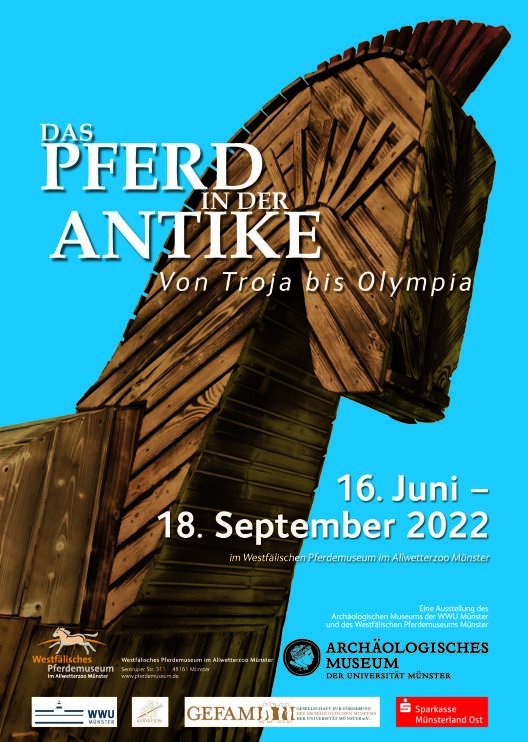
Special exhibitions

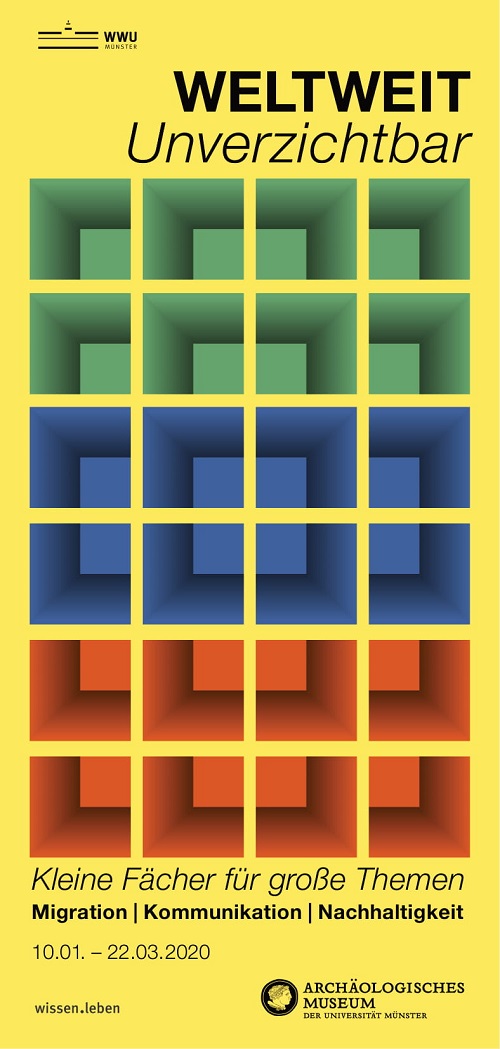
"WorldWideIndispensable - Small Subjects for Big Topics"
(10 January to 22 March 2020, early end on 12 February 2020 due to the Corona pandemic)
Number of visitors: 2221
In today's global world, we live in societies that are rapidly and constantly changing. This dynamic is a challenge that needs to be addressed. Armed conflicts, human rights violations, inequality, environmental pollution and populism are just some of the societal problems we face. Understanding them also means considering approaches to solutions. The so-called "small subjects" in the humanities make a contribution to this.
As part of the "Small Subjects Weeks", we are showing an exhibition at the University of Münster that does not focus on old familiar things, but presents global phenomena using small things. On the basis of three social challenges - migration, communication and sustainability - we give an insight into how we look at core questions and problems of modern society and thus contribute to the understanding of these topics.
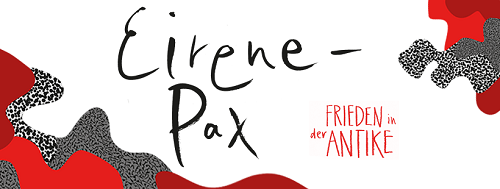
"Eirene - Pax. Peace in Antiquity"
28 April - 02 September 2018
Number of visitors: 6499
As part of the Münster cooperation exhibition "Peace. From Antiquity to the Present Day", the Archaeological Museum of the WWU Münster is showing the partial exhibition "Eirene/Pax. Peace in Antiquity" with exhibits from the period from the 8th century BC to the 3rd century AD. The focus of the exhibition is the significance of peace in Greek and Roman antiquity. The oldest preserved peace treaty in the world between the Hittite Empire and Egypt (1259 BC) will also be on display.
Approaches to peace treaties in Greece are offered, for example, by high-ranking painted vessels and a document relief from Athens on which the city goddesses of Athens and Samos seal a treaty of alliance. The famous statue of Eirene, the goddess of peace, which was probably erected in the state market of Athens in 375 BC, is a magnificent sculpture representing new paths to peace after the devastating Peloponnesian War. Peace takes shape in her.
In the Roman Empire, the goddess of peace Pax is depicted as the giver of wealth on coins, jewellery stones and the peace altar of Emperor Augustus (ara pacis). Altars also celebrate the peace won by this emperor in the provinces, as a specimen from Narbonne attests. The peace forum of Emperor Vespasian (templum pacis) is decorated with high-ranking art: The statue of the dying Gaul stands for this.
An important aspect is the examination of symbols and gestures of peace from the entire Greco-Roman antiquity: Victory is visualised by the goddess Victoria, various victory marks and piles of weapons. Feast, kiss, embrace, handshake, cornucopia, branch and messenger's staff are symbols of peace - as are the cities of peace.

"Death and Eternity. The Münster Mummy in the Focus of Research".
19 November 2016 until 22 January 2017
Number of visitors: 3773
In 1978, an ancient Egyptian wooden coffin with a mummy was given to the Archaeological Museum of the WWU Münster as a permanent loan from the Konrad-Ziegler-Gymnasium (Mülheim/Ruhr). Both the coffin and the mummy were comprehensively restored last year and are the focus of this special exhibition.
The scientific research of this mummy was the starting point for the discussion about the handling of the deceased in different cultures and times - not least our handling of the presentation of mummies in museums. The exhibition presents the results of this dialogue between Egyptologists, mummy researchers and philosophers and invites visitors to work out their own approach to this exciting and complex topic.
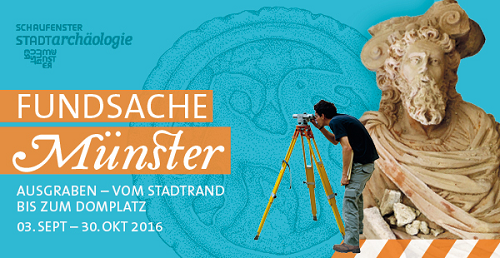
"Lost Property Münster. Excavating - From the outskirts to the cathedral square".
03 September - 30 October 2016
Number of visitors: 3674
In 2001, the city archaeology department was established as part of the municipal monument preservation service in münster. Since then, it has accompanied building projects in Münster and the surrounding area in accordance with the NRW Monument Protection Act. So far, more than 30 projects have yielded scientifically interesting finds and features documenting the history of the city from its earliest settlement through the Middle Ages to modern times.
This exhibition is intended to provide examples of the archaeological knowledge of the city's history and to give an interim report on the work and results of the city's archaeology over the past 15 years. Selected finds represent the wealth of historical legacies and provide insight into Münster's historical everyday life and urban development.
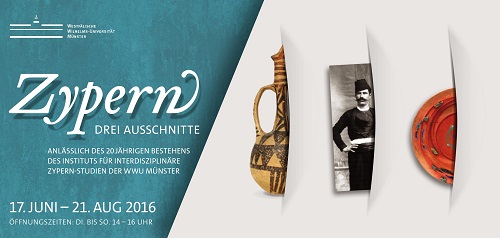
"Cyprus. Three excerpts"
17 June - 21 August 2016
Number of visitors: 872
20 years ago, the Institute for Interdisciplinary Cyprus Studies was founded at the WWU Münster. This anniversary is the occasion for an exhibition conceived by the Institute together with the Archaeological Museum. On display for the first time are all the ancient Cypriot objects from the holdings of the Archaeological Museum as well as some antiquities from the Archaeological Museum of the University of Giessen and exhibits from other lenders such as the Cypriot Embassy in Berlin.
Large-format black-and-white photographs by the Bank of Cyprus Cultural Foundation form the second part of the exhibition. They show cities, landscapes and people of Cyprus at the turn of the 19th and 20th centuries: Glimpses of a time long gone.
Objects by the artist Angela B. Clement, all of which revolve around the theme of copper, form the third part of the exhibition. Her exploration of this metal is a conscious reference to Cyprus, whose name Κυπρος (engl. Cyprus) translates as copper.
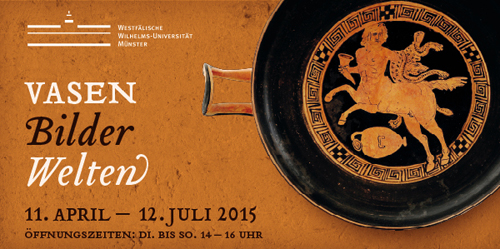
"Vases Pictures Worlds" (11 April 2015 - 12 July 2015)
Number of visitors: 1242
A total of 115 painted clay vessels from the Dr Dietmar Jordan Collection were presented in this special exhibition - 61 of them in public for the first time. They were mostly vases from the Greek cultural area and a few from its neighbouring areas, spanning a period of five centuries (8th - 3rd century BC). The exhibition was divided into four sections: The first part offered an overview of vase painting in Greek antiquity, showing all the epochs and landscapes represented in the private collection. This was followed by a group of seven extremely exquisite vessels with particularly high-quality vase paintings. The main section provided an insight into the worlds of pictures: These 18 showcases were thematically structured (e.g. animal images, sport, war, Dionysian goings-on) and culminated in the depictions of Heracles, the collector's favourite hero. The final display was made up of a few vessels documenting the history of the collection.
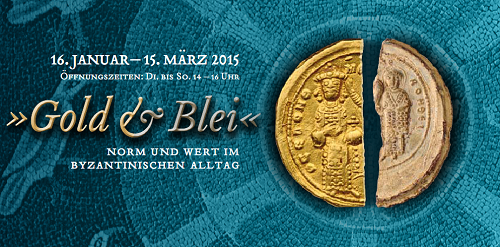
"Gold and Lead - Norm and Value in Byzantine Everyday Life" (16 January - 15 March 2015)
Number of visitors: 979
The exhibition "Gold and Lead - Norm and Value in Byzantine Everyday Life", organised on the occasion of the 50th anniversary of the Institute for Byzantine and Neo-Grecian Studies at the WWU Münster, used selected objects to make visible the orders and values on which Byzantine everyday life was based and how rules and regulations influenced and guided it. Calibrated weights and unadulterated money were used in the marketplace to ensure the regulated and controlled exchange of goods. Lead seals and metal stamps guaranteed the integrity of consignments, while Byzantine gold coins as the leading currency followed a fixed standard until the High Middle Ages and reflected imperial power.
Religious life experienced a new orientation in late antiquity: with the toleration of Christianity by Emperor Constantine I. (306-337), the cross became the Christian sign in all areas of social life. Many objects in use in daily life testified to the rapid spread of the new faith. From the holdings of the university's archaeological museum as well as from private collections, such everyday and liturgical objects (lamps, pilgrim ampoules, processional crosses and reliquary crosses) were presented alongside gold coins and lead seals.
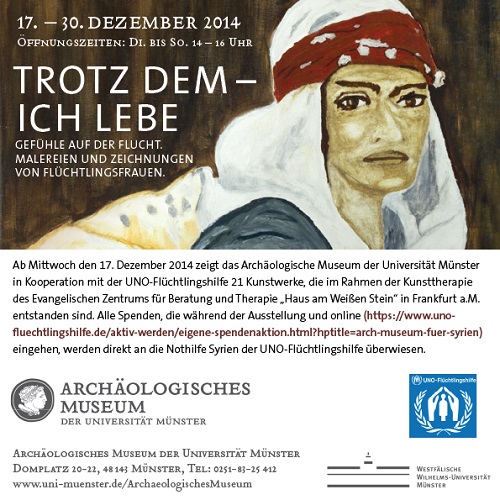
Special exhibition UNESCO Refugee Aid "Nevertheless - I live" (17 - 30 December 2014)
Number of visitors: 343
From 17 December - 30 December 2014, the Archaeological Museum of the Westphalian Wilhelms University Münster presented the exhibition "Despite this - I live" in cooperation with UNESCO Refugee Aid. The exhibition showed impressive pictures that let the viewer share in the emotions of refugees. The works were created as part of art therapy at the Protestant Centre for Counselling and Therapy "Haus am Weißen Stein" in Frankfurt am Main. All donations collected during the exhibition and online went to the UN Refugee Agency's emergency aid for Syria.
Pain, fear, despair, but also courage, hope and the will to live were reflected in the 21 works of art that the refugee women created together with art therapist Barbara Wilz. Each of us knows these feelings, but fortunately most of us have not yet had to experience them with such intensity.
In 2014, more than half of the Syrian population were refugees. According to UNHCR statistics, Syria was and still is the country with the second highest number of refugees worldwide and the highest number of people who had to flee within their own country. An end to the crisis is not in sight. The steady flow of refugees is mainly affecting neighbouring countries, as they are already taking in refugees beyond their capacity. "We are doing everything we can," stresses UN Refugee Commissioner António Guterres. But especially in winter, a worsening of the supply situation in the refugee camps was generally expected.
The Archaeological Museum of the Westphalian Wilhelms University would therefore like to invite you to get involved in the emotional world of refugees and to support people in such an emergency situation with your donations.
You can find more information about emergency relief in Syria on the homepage of UN Refugee Aid (www.uno-fluechtlingshilfe.de).
Online donations at: https://www.uno-fluechtlingshilfe.de/aktiv-werden/eigene-spendenaktion.html?hptitle=arch-museum-fuer-syrien
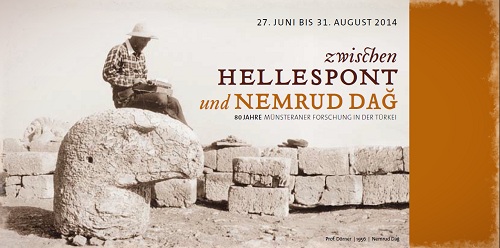
Between Hellespont and Nemrud Dağ - 80 Years of Münster Research in Turkey (27 June to 31 August 2014, extended until 12 October 2014).
Number of visitors: 4816
The exhibition "Between Hellespont and Nemrud Dağ" at the Archaeological Museum of Münster University (WWU) presented 80 years of Münster research in Turkey from 27 June to 12 October. It looked back on major projects of the WWU in the south-eastern Turkish region of Kommagene, where ancient historians from Münster made numerous finds in the course of the 20th century. The exhibition focused on the ruler cult around King Antiochos I in the 1st century BC in south-eastern Turkey.
Special attention was given to the presentation of the work of the Münster antiquities scholar Prof. Dr. Friedrich-Karl Dörner, who died in 1992. At the same time, the exhibition deals with the interplay between religion and politics, which is essential for the Cluster of Excellence, such as the ruler cult founded by Antiochos I, which included the deification of the royal family as a central element.
The exhibition presented diverse exhibits, including the plaster cast of a prehistoric limestone figure from the 8th millennium BC, which was found near Kilisik and represents one of the earliest examples of a Neolithic cultural stage. Also on display were a model of the burial sanctuary of Antiochos I on Nemrud Dağ, showing the ruler surrounded by the gods of his pantheon, and coins of the city of Alexandreia Troas from the 3rd century AD, whose images tell of the creation of the sanctuary of Apollo Smintheus and the founding of the city.
The exhibits also included finds from the ancient sanctuary of the god Iuppiter Dolichenus in south-eastern Turkey. Other exhibits came from the ongoing Münster project in Patara as well as from activities going back further, for example from Pergamon, Alexandria Troas and Lysimacheia. The LWL State Museum of Art and Culture in Münster contributed found coins from the Late Classical period to the High Medieval period.
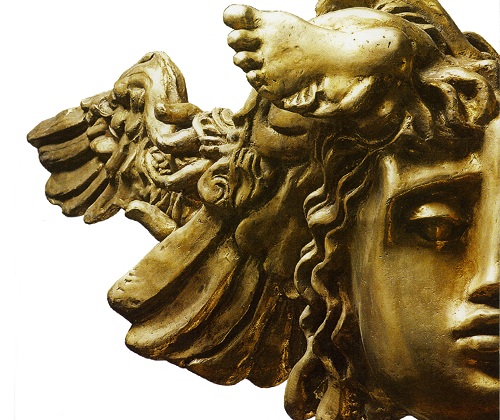
Alexander Burganov - Ancient Dream Images (31 August - 01 December 2013)
Number of visitors: 6673
When Prof. Alexander Burganov from Moscow approached us in 2012 with the wish to have sculptures and graphics created by him enter into a dialogue with the ancient originals in the Archaeological Museum of the University of Münster, we gladly accepted this idea. In particular, we were convinced by his approach, which is represented in the title "Antike Traumbilder" ("Ancient Dream Pictures"), of having his interpretations of ancient pictorial themes correspond with the originals, some of which are over two thousand years old.
The Greeks and Romans themselves had a much closer relationship to dream images than people do today. They saw in them the utterance of the gods, who wanted to pass on their advice to people through this channel. Reflecting this view were two stories about Apollo and Prometheus, which portrayed these two as the "first inventors" of dreams. It is striking that the respective encoding of the message by the gods was done so that the need for interpretation of the dream images secured the entire complicated system of communication between gods and humans.
With over 6600 visitors, the exhibition was by far the most successful to date!
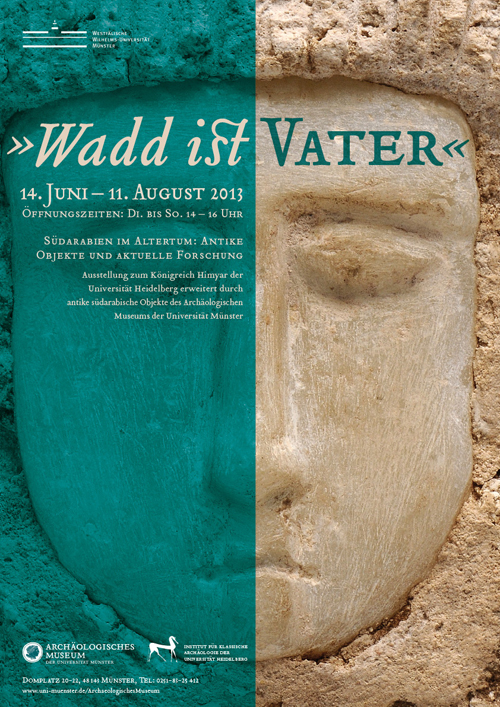
Wadd's Father. South Arabia in Antiquity: Ancient Objects and Current Research (14 June - 11 August 2013)
Number of visitors: 759
Southern Arabia was an extraordinarily valued landscape in antiquity. The area, which roughly corresponds to the present-day Republic of Yemen, was called Arabia Felix, i.e. Happy Arabia, in antiquity. The region became famous for its rich supply of incense. For example, the Queen of Sheba, as recorded in the Bible, brought the coveted aromas of myrrh and frankincense with her to Jerusalem on the occasion of a visit to King Solomon.
"Wadd is Father" is the inscription on a stone amulet that belongs to the part of the exhibition that offers a representative overview of the small-scale art of ancient South Arabia. These original objects are combined with a scientific documentation of the University of Heidelberg, in which current research on Himjar, an almost forgotten empire of the 2nd to 6th century AD, is presented.

